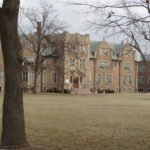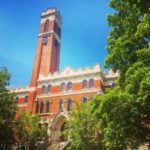Sarah Lawrence College Essay Example by an Accepted Student
Sarah Lawrence College is a private liberal arts college located just outside of New York City. Well-known as one of the best liberal arts schools in the college, Sarah Lawrence offers students an exceptional education. Not to mention, the suburban campus just a 15 minute train ride away from NYC provides students with the perfect balance between a traditional campus experience and the excitement of a big city.
Gaining admission to Sarah Lawrence requires more than just a strong academic and extracurricular profile. Students wishing to attend will also need a stellar essay, which is where we can help. In this post, we will go over a real essay an accepted Sarah Lawrence applicant submitted and discuss what it did well and where it could be improved.
Please note: Looking at examples of real essays students have submitted to colleges can be very beneficial to get inspiration for your essays. You should never copy or plagiarize from these examples when writing your own essays. Colleges can tell when an essay isn’t genuine and will not view students favorably if they plagiarized.
Read our Sarah Lawrence essay breakdown to get a comprehensive overview of this year’s supplemental prompts.
Sarah Lawrence Essay Example: Hyphenates
Prompt: Sarah Lawrence students are often described as hyphenates: director-playwright-sound designer, environmentalist-photographer, journalist-linguist, economist-poet. In 250-500 words, tell us about seemingly disparate interests you’ve brought together, or hope to bring together at Sarah Lawrence. (250-500 words)
Among blue abstract faces and messy paint splatters, I took my first steps. My childhood evokes memories of brightly colored canvases, stained overalls, and folk music. Being born into a family of eccentric artists, I grew up surrounded by the vibrant emotion that characterizes my mom’s paintings and my dad’s comics. I’ve proudly adopted their artistic habits, inspired by their open-mindedness and fierce self-expression. By exploring unconventional mediums, everything from collage-making to spoken word, I’ve realized that my identity as an artist knows no bounds.
In a society that undervalues teenage perspectives, I watched the Gen-Z artists around me struggle to find a place for their self-expression that celebrates the inexperienced and experienced alike. Countless arts publications only accept work from highly accomplished teenage creatives, limiting the potential for creative experimentation among youth artists. Seeking to be the change I wish to see in the world, I took action. I created an online literary and arts magazine to provide teen artists with a platform to build community, practice creativity, and publish their work in a judgment-free zone. Watching hours of Youtube tutorials, I taught myself to design a website using online programs. As I found myself scribbling stanzas and sketching in my notebook while learning how to code, I realized that my identity as a 21st-century artist can extend into technology. As an oddball artist-activist-computer scientist, I feel driven to express myself creatively and scientifically to enact social change.
As my magazine gained traction online, garnering 3.5k+ views worldwide, I discovered the power that digital media has to share marginalized perspectives. I questioned how I could continue harnessing technology’s potential to amplify overlooked stories, merging STEM with my penchant for Artivism. Within my school’s student-athlete centric community, I noticed that countless other students’ unique accomplishments were sidelined. Promoting inclusivity, I worked alongside my student newspaper team to create a collaborative Youtube Channel. Together, we launched a video project to film interviews with students whose stories go frequently overlooked. Once again, I found myself challenging conventional expectations for an artist. As I expressed myself creatively by directing video production for the project, I also excitedly encountered data sets within video editing and statistics within sound design.
I once thought I was exclusively “right-brained” but I’ve learned that I am most fulfilled when both sides of my brain work in tandem, drawing innovative connections between STEM and the arts. At Sarah Lawrence, I hope to continue my exploration as I work toward my goal of self-publishing a poetry book and creating a podcast to highlight female Latinx artists. Pursuing my artistic instincts, I’d challenge myself to dig deep and advocate for social justice in untraditional ways. Though I wandered into the world of computer science on accident as an out-of-place artist, I emerged from it with a new understanding of what art means – taking risks with an open mind. Embodying art’s spirit of adventure, I’m eager to continue forging intersections between art, advocacy, and technology.
What the Essay Did Well
This essay is engaging, well-written, showcases the student’s interests, highlights her accomplishments, and perfectly answers the prompt. That’s not an easy thing to do, so let’s break down what works so well.
In terms of the writing quality, this student uses imagery and details to paint a picture for the reader. Right off the bat, we are transported to her childhood home and can imagine a young kid growing up surrounded by art. The level of detail is maintained throughout the essay to thoroughly explain the projects she spearheaded. Her diction is also the perfect balance between being well-spoken, but still sounding like a teenager. Referring to herself as “oddball” and coining the term “Artivism” bring a level of familiarity to the essay that makes it seem like she is talking to a friend rather than an admissions committee—which is the goal.
The essay does an incredible job of showing the reader this student’s interest in not just two subjects, but three. Halfway through the essay, she tells us she’s an “artist-activist-computer scientist”, but we already identified those qualities ourselves just by reading about her desire to highlight marginalized voices, work with art, and code a website. This is a great example of showing, not telling. You want the reader to draw their own conclusions about you without you having to spell it out for them.
Because the student shows the reader her interests through her achievements, we also get to see what she has accomplished. Since she uses the projects she developed as tools to tell her story, it doesn’t feel like we are reading a brag sheet. The key is to describe your actions and explain why it made sense for you to engage in them, as this essay has done.
Between the effective story-telling and the high level of detail for her multiple interests, we can walk away without a doubt that this student fully answered the prompt. We end the essay remembering her as an artist-activist-computer scientist, making this essay a huge success.
What Could Be Improved
This is a very strong essay and there’s not that much that needs improvement. However, one way this student could improve the flow of the essay would be to break up large paragraphs into smaller, more digestible ones. When there are only three paragraphs in an essay of 500 words, it puts more pressure on the reader to stay focused and make their way through big chunks of text.
There are two natural breaks in the body paragraph that could have split it into three, more focused, paragraphs. The first break would be after this sentence, “Watching hours of Youtube tutorials, I taught myself to design a website using online programs.” Then, there would be a new paragraph about the student discovering the marriage of art and computer science, which would be more poignant because it’s presented as a fresh idea to the reader and it wouldn’t be lost in a sea of words. The other break would occur right before she switches to talking about the video project for athletes, as that’s a new accomplishment that deserves its own paragraph.
Where to Get Feedback on Your Essay
Want feedback on your Sarah Lawrence essay before you submit? That’s why we created our free Peer Essay Review tool, where you can get a free review of your essay from another student. You can also improve your own writing skills by reviewing other students’ essays.
If you want a college admissions expert to review your essay, advisors on CollegeVine have helped students refine their writing and submit successful applications to top schools. Find the right advisor for you to improve your chances of getting into your dream school!



